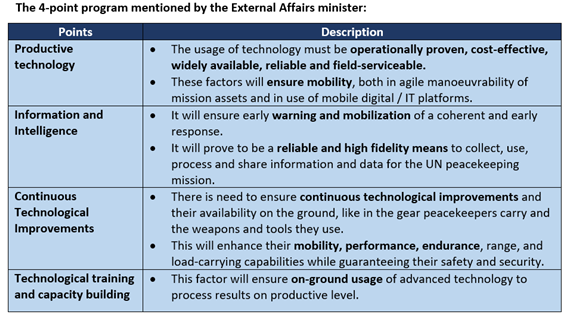Wednesday, 25th August 2021
Fresh SDR allocation may bump up forex reserve
In News
The International Monetary Fund (IMF) has credited additional special drawing rights (SDRs) in the accounts of each country.
About the News
- The Allocation: As part of its $650 billion global liquidity push, the IMF has credited additional special drawing rights (SDRs) in the accounts of each country. It will be allocated in proportion to the respective country’s quota in IMF.
- India is likely to receive around $17.94 billion based on its existing quota of 76% quota at the IMF.
- Global liquidity push: A fresh SDR has been issued to help the least developed and developing countries facing a foreign exchange crunch because of the coronavirus pandemic.
- This move will not worsen the fiscal position of these countries because it will be given free to all.
- Criticism: The move has been criticized for being asymmetrical, with as much as 62% going to advanced economies like US, EU, and UK and only 3% to LICs (low-income countries). This is no substitute for a comprehensive IMF reform.
What are special drawing rights?
- SDR is an international reserve asset created by the IMF, comprising the dollar, euro, yen, sterling, and yuan, and allocated to its members in the proportion of their quota in IMF.
- The value of the SDR is set daily by the IMF which depends on relative daily market exchange rates of currencies included in the basket. The SDR also serves as the unit of account of the IMF.
- It is not a currency, nor a claim on the IMF, but is potentially a claim on freely usable currencies of IMF members. It cannot be held by private entities or individuals.

What can a country do with Special Drawing Rights?
- Members can exchange SDRs for freely usable currencies among themselves and with prescribed holders.
- IMF members can also use SDRs in a range of other authorized operations among themselves (e.g. loans, payment of obligations, pledges) and
- In operations and transactions involving the IMF, such as the payment of interest on and repayment of loans, or payment for quota increases.
Source:
- Fresh SDR allocation may bump up forex reserve
- Making Special Drawing Rights (SDRs) work better for global development
- Questions and Answers on Special Drawing Rights
Image Source:
Procedure to arrest a cabinet minister in India
In News
The recent arrest of a Union Minister and Rajya Sabha member by the Maharashtra government has started the debate about the Cabinet Minister Arrest Procedure in India.
About the News
- Three FIRs have been registered against a Union Minister and Rajya Sabha member in connection with his recent speech.
- The arrest has been claimed to be against the protocols of arrest of cabinet ministers and parliamentary privileges enjoyed by them.
Procedure to arrest a cabinet minister in India
- Parliament in Session: If Parliament is not in session, a cabinet minister can be arrested by a law enforcement agency in case of a criminal case registered against him.
- Reason for Arrest: Section 22 A of the Rules of Procedures and Conduct of Business of the Rajya Sabha states that the Police, Judge or Magistrate would, however, have to intimate the Chairman of the Rajya Sabha about the reason for the arrest, the place of detention, or imprisonment in an appropriate form.
- Role of Chairman of RS: The Chairman is expected to inform the Council if it is sitting about the arrest. If the council is not sitting, he/she is expected to publish it in the bulletin for the information of the members.
- Parliamentary Privileges: As per the main privileges of Parliament, in civil cases, they have freedom from arrest during the continuance of the House and 40 days before its commencement and 40 days after its conclusion, as per section 135 of the Code of Civil Procedure.
- The privilege of freedom from arrest does not extend to criminal offences or cases of detention under preventive detention.
- Precincts of the House: No arrest, whether of a member or of a stranger, can be made within the precincts of the House without the prior permission of the Chairman/Speaker and that too in accordance with the procedure laid down by the Home Ministry in this regard.
- Similarly, no legal process, civil or criminal, can be served within the precincts of the House without obtaining the prior permission of the Chairman/Speaker whether the House is in Session or not.
Sources:
ISRO Protocol to Track Stubble Burning Data
In News
The Commission for Air Quality Management (CAQM) has directed Delhi and its neighbouring states to adopt and implement a standard protocol developed by Indian Space Research Organisation (ISRO) for monitoring data and fire incidents related to paddy residue burning.
About the News
- No Standardization: There has been no standard protocol in place on the monitoring of stubble burning incidents, as well as proper data collection for the Centre and the state governments.
- States have been collecting data through multiple agencies in multiple ways, and therefore there were gaps in the collection as well as the monitoring.
- Pollutants: Open stubble burning emits large amounts of toxic pollutants in the atmosphere which contain harmful gases like methane (CH4), Carbon Monoxide (CO), Volatile organic compound (VOC) Nitrogen oxides (NOx), Sulphur oxides (SOx), carcinogenic polycyclic aromatic hydrocarbons and Particulate matter (PM10 and PM2.5).
- CAQM Directive: The CAQM has now asked the governments of Delhi, Punjab, Haryana, Uttar Pradesh and Rajasthan to develop a time-bound comprehensive action plan and adopt standard protocol for estimation of stubble burning fire events using satellite data.
What is the ISRO Protocol to Track Stubble Burning Data?
- Satellites: The protocol developed by the ISRO is based on remote sensing technology. The Imager payload onboard ISRO’s INSAT-3D & 3DR satellites is used to monitor Aerosol Optical Depth (AOD),
- AOD is an indicator of particles and smoke from biomass burning affecting visibility and increase of PM2.5 and PM10 concentration in the atmosphere.
- Mapping pollutants: AOD, PM2.5 and PM10 spatial maps and stubble burned area maps are generated at the end of stubble burning activity in Kharif season.
- Origins: ISRO has been carrying out monitoring of stubble burning since 2015. The products generated are comparable to the NASA products.
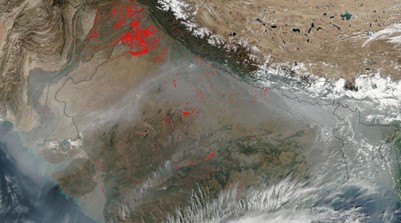
What is CAQM?
- CAQM is mandated to look at the mitigation and management of stubble burning in the NCR, which leads to high levels of air pollution and poor air quality every winter.
- It was set under the Commission for Air Quality Management in the National Capital Region and the Adjoining Areas Act, 2021. It replaced the Environmental Pollution (Prevention and Control) Authority (EPCA) that was appointed by the Supreme Court
Source:
Montreal Protocol
In News
The Union Cabinet has recently ratified the Kigali Amendment to the Montreal Protocol on materials that deplete the ozone layer.
About the News
- Kigali Amendment to the Montreal Protocol on Substances that Deplete the Ozone Layer for phase down of Hydroflurocarbons (HFCs) was adopted by the Parties to the Montreal Protocol on October, 2016 at Kigali, Rwanda.
- India’s Commitments:
- National strategy for phase down of HFCs will be developed after required consultation with all the industry stakeholders by 2023.
- Amendments to the existing legislation framework, the Ozone Depleting Substances (Regulation and Control) Rules, will be done by mid-2024.
- India will complete its phase down of HFCs in 4 steps from 2032 onwards with cumulative reduction of 10% in 2032, 20% in 2037, 30% in 2042 and 85% in 2047.
What is the Kigali Amendment to the Montreal Protocol?
- About: Under the Kigali Amendment, Parties to the Montreal Protocol will phase down production and consumption of Hydrofluorocarbons, commonly known as HFCs.
- Global Warming Potential of HFCs: HFCs were introduced as non-ozone depleting alternative to chlorofluorocarbons (CFC) such as R-12 and hydrochlorofluorocarbons (HCFC) such as R-21.
- While HFCs do not deplete the stratospheric ozone layer, they have high global warming potential ranging from 12 to 14,000, which have adverse impact on climate.
- Phase-out Timeline: Recognizing the growth in use of HFCs, especially in Refrigeration and Air-conditioning sector, the Kigali amendment adds HFCs to the list of controlled substances and approved a timeline for their gradual reduction by 80-85 per cent by the late 2040s.
What is the Montreal Protocol?
- About: The Montreal Protocol on Substances that Deplete the Ozone Layer is the landmark multilateral environmental agreement that regulates the production and consumption of nearly 100 man-made chemicals referred to as ozone depleting substances (ODS).
- Adopted on 15 September 1987, the Protocol is to date the only UN treaty ever that has been ratified every country on Earth - all 198 UN Member States.
- The original Montreal Protocol was the first step in international efforts to protect stratospheric ozone.
- Working Structure: The Montreal Protocol phases down the consumption and production of the different ODS in a step-wise manner, with different timetables for developed and developing countries (referred to as “Article 5 countries”).
- Accountability Mechanism: All parties have specific responsibilities related to the phase out of the different groups of ODS, control of ODS trade, annual reporting of data, national licensing systems to control ODS imports and exports, and other matters.
- Developing and developed countries have equal but differentiated responsibilities, but both groups of countries have binding, time-targeted and measurable
- ODS included the Treaty: The substances controlled by the treaty are CFCs, halons, other fully halogenated CFCs, carbon tetrachloride, methyl chloroform, HCFCs, methyl bromide and HFCs.
- India’s membership: India became a Party to the Montreal Protocol on Substances that Deplete the Ozone Layer on 19 June 1992. India has successfully met the phase out targets of all the Ozone Depleting Substances as per the Montreal Protocol Schedule.
Why was the Montreal Protocol brought into force?
- Ozone layer depletion recognized: In 1974, it was discovered that emissions of CFCs were depleting ozone in the stratosphere. In the early 1980s, scientists observed a thinning of the ozone layer over Antarctica.
- ODS presence in consumer products: ODS like CFCs, HCFCs and halons eventually reach the stratosphere where they are broken apart to release ozone-depleting chlorine atoms.
- Human exposure to UV rays: Overexposure to UV is one factor contributing to an increase in melanoma, in addition to other factors.
- Over the last 30 years, the skin cancer incidence has gone from 1 in 1500 to 1 in 75.
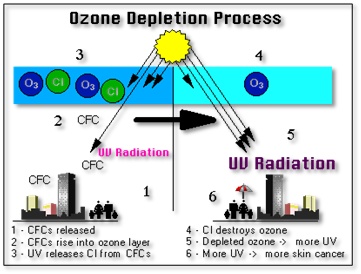
The Montreal Protocol Success Story
- Phasing Out of ODS: The Montreal Protocol is considered to be one of the most successful environmental agreements of all time. To date, the Parties to the Protocol have phased out 98% of ODS globally compared to 1990 levels.
- Global warming reduction: As most of ODS are potent greenhouse gases, the Montreal Protocol is also contributing significantly to the protection of the global climate system.
- From 1990 to 2010, the treaty’s control measures are estimated to have reduced greenhouse gas emissions by the equivalent of 135 gigatons of CO2.
- Preventing Health Disasters: Without this treaty, ozone depletion would have increased tenfold by 2050 compared to current levels, and resulted in millions of additional cases of melanoma, other cancers and eye cataracts.
- As per estimations, Montreal Protocol is saving an estimated two million people each year by 2030 from skin cancer.
- Contribution to SDGs: The Montreal Protocol also makes important contributions to the realization of the UN Sustainable Development Goals like SDG Goal 1, 2, 3, 7 etc.
- Example SDG Goal 1 (End poverty in all its forms everywhere): The Montreal Protocol supports industrial enterprises and their technicians to successfully transition to new technologies that do not deplete the ozone layer. This creates employment and helps achieve SDG Goal 1.
- Dynamic Treaty: The treaty evolves over time in light of new scientific, technical and economic developments, and it continues to be amended and adjusted.
- The Montreal Protocol has been successful because of scientific accuracy, effective public policy, and market-based, flexible, innovative approaches to ensuring ozone layer protection and developing alternatives.
Conclusion: With the full and sustained implementation of the Montreal Protocol, the ozone layer is projected to recover by the middle of this century. The Montreal Protocol is considered to be one of the most successful environmental agreements of all time. What the parties to the Protocol have managed to accomplish since 1987 is unprecedented, and it continues to provide an inspiring example of what international cooperation at its best can achieve.
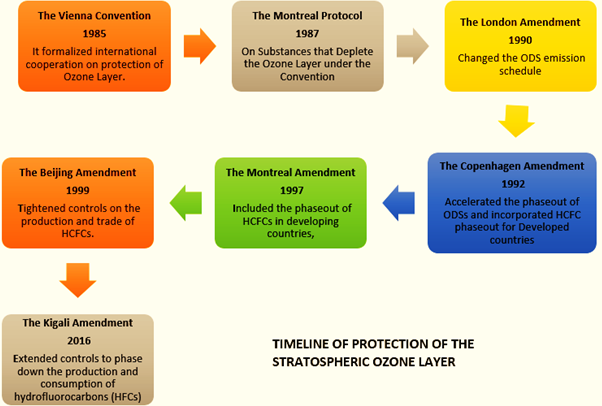
Question: What is the Montreal Protocol? How far has it been successful in achieving its targets and the reasons behind the success?
Sources:
- About Montreal Protocol
- India decides to ratify Kigali Amendment to Montreal Protocol
- Cabinet approves Ratification of Kigali Amendment to the Montreal Protocol
- The Depletion of Stratospheric Ozone and its destructive effects of Life on Earth
- The 20th Anniversary of the Montreal Protocol on Substances that Deplete the Ozone Layer
- International Treaties and Cooperation about the Protection of the Stratospheric Ozone Layer
This Day in History - Indianization of the Army
On August 25, 1917, the first concrete step towards the Indianisation of the Army was initiated when seven selected Indians, serving the Army, were granted King’s Commission in the Infantry and the Cavalry. The term Indianisation is used to describe the process of introducing Indians into the Commissioned ranks of the defence forces in India. Over 1.5 million soldiers from Indian Subcontinent went to the World War I.
![]()
Sources:
Image of the Day - Fishing Cat
This is the image of fishing cat, that has been recently sighted around the banks of the Ken river that flows through the Panna Tiger Reserve in Madhya Pradesh. Although the fishing cat was first photographed on January 11, 2019, the confirmation about the presence of this endangered species was announced on August 13, 2021. According to Schedule 1 of the Wild Life (Protection) Act, 1972, hunting the fishing cat is forbidden. The fishing cat is twice the size of the domestic.

Source:
Covid in India: Endemic
- Context: The WHO Chief has stated that COVID-19 in India may be entering the stage of endemicity.
- Endemicity is the constant presence of a disease or infectious agent within a given geographic area or population group which means that the disease spread and rate of illness is
- The endemic stage is when a population learns to live with a virus.
- It’s very different from the epidemic stage when the virus overwhelms a population.
- Considering the size of India, its heterogeneity of population and immunity status in different parts of the country, it is feasible that low and moderate levels of transmission of the infection may continue, which might pave the way for India to enter some kind of stage of endemicity.

Source:
- Covid in India may be entering endemic stage, WHO chief scientist Soumya Swaminathan says
- Covid in India May be Entering Stage of 'Endemicity'. What it Means & Why You May Never be Able to Bid Virus Adieu
- Endemic or epidemic? Measuring the endemicity index of diabetes
Image Source:
The Saroop of Sikh Holy Book
- Context: Devotees were seen carrying saroops of the Guru Granth Sahib brought back by Afghan Sikh evacuees at Delhi airport.
- Saroop is a physical copy of Sri Guru Granth Sahib, also called Bir in Punjabi. Every Bir has 1,430 pages, which are referred to as Ang and the verses on every page remain the same.
- The Sikhs consider the saroop of Guru Granth Sahib a living guru and treat it with utmost respect.
- They believe that all the 10 Gurus were the same spirit in different bodies and the Guru Granth Sahib is their eternal physical and spiritual form.
- Guru Arjan Dev-the fifth Guru compiled the first Bir in 1604 and installed it at the Golden Temple in Amritsar.
- Later, Guru Gobind Singh-the tenth Guru added verses penned by the ninth Guru, Guru Tegh Bahadur and it was in 1708 that Guru Gobind Singh declared the Guru Granth Sahib the living Guru of the Sikhs.
- Five baptized Sikhs are required to transfer the Guru Granth Sahib from one place to another carrying it on their head with barefoot as a mark of respect and Gurdwaras have a separate resting place for the Saroop, called ‘Sukh Asan Sthan’ or ‘Sachkhand’ where the Guru rests at night.
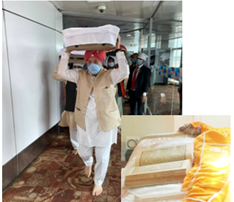
Source:
Image Source:
Operation Devi Shakti
- Context: India has been evacuating stranded people from Afghanistan under Operation Devi Shakti.
- Not only minorities like Hindus and Sikhs, but also the Afghan Nationals are being airlifted and flown down via special aircrafts of the Indian Air Force (IAF).
- Thousands of Afghans have been crowding around the Kabul airport for nearly a week in a desperate attempt to flee the country fearing the Taliban's brutality.
- India as a relief measure is carrying out the evacuation missions in coordination with the US and several other countries.
- India has so far evacuated more than 800 people since the Taliban seized power in Afghanistan.
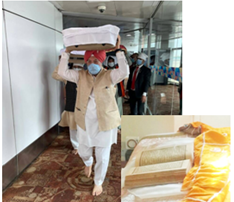
Source:
- 'Operation Devi Shakti': India evacuates more than 800 people from Afghanistan
- India's Evacuation Drive from War-Torn Afghanistan Has A 'Durga Maa' Connect. Here's Why
Image Source:
India’s first mRNA vaccine
- Context: India’s first mRNA vaccine against Covid has been found to be safe and has been approved by the Drugs Controller General of India (DCGI) to move into Phase II and III of clinical trials.
- This indigenous vaccine uses the same messenger RNA-technology (mRNA) based platform that has been exploited successfully by Moderna and Pfizer-BioNTech to come out with the world’s two most successful vaccines with around 95% efficacy against the Covid-19 epidemic.
- mRNA vaccines teach our cells how to make a protein or even just a piece of a protein that triggers an immune response inside our bodies.
- The vaccine has been developed by Gennova Biopharmaceuticals Ltd, a Pune-based company with support from the Department of Biotechnology.
Source:
- India's first mRNA Covid vaccine safe in early trials, say regulators
- India’s first mRNA vaccine against Covid found to be safe, gets approval for phase II and II trials
- Understanding mRNA COVID-19 Vaccines
The legal challenges in recognising the Taliban
The article revolves around the conundrum around recognising Taliban as the new government of the state. For recognising the governments certain doctrines are in place like, the test of effectiveness and the test of democratic legitimacy. A Taliban-led government fulfils the former one but not the latter, which is not a binding requirement to recognise a government.
Recognition of government is vital as it is important to know who the governing authority of the state is. With two of the members of United Nations Security Council showing their readiness to recognise Taliban led government, India should also make its stand clear considering various dimensions of geo-politics.
Why you should read the article?
- To understand the factors to be considered for recognising a government.
- Factors that India should appraise while taking its call towards Taliban led government.
Source:
Power Markets on the Cusp of Transformation
Essence: The article talks of how the power market has enabled provision of electricity to 700 million people since the year 2000. Power purchase through power exchanges, price discovery, and value chain mechanism has enabled such growth. The long-term power purchase agreements and power markets are the places from where electricity is traded for long and short term. The introduction of longer duration delivery contracts (LDCs), that go beyond 11 days has helped make the mechanism more flexible. It helps in competitive pricing and reduction in the NPAs along the supply chain.
Why you should read this article?
- To understand the mechanism of power trade in India
- To get an insight into types of contracts in power sector
Source:
Designing a climate law for India
Essence: The article argues for a climate law which focuses on institutional, technical, and financial capacity building and lay the structural foundations for success in mitigation and adaptation. It talks about the drawbacks of the current carbon cap law, which has developmental costs, problems in achieving political consensus and non-transformative. Whereas a law enabling a low carbon transformation has the advantage of being effective, efficient, and bringing prosperity.
Why you should read this article?
- To understand the need for climate law and the two visions of climate legislation across the country.
- To understand the Indian context and the problems of a conventional carbon capping law.
- To know about the advantages of a low carbon transformation enabling law has over a law restricting carbon emissions.
Source:
Sanitation Safety Planning
Background
- Nearly 4.2 billion people in world do not have access to safe sanitation. People defecate in the open, putting themselves in the way of a myriad of diseases.
What is Sanitation Safety Planning (SSP)
- It is a step-by-step risk-based technique that assists implementation of local-level risk assessment and management for an entire sanitation service chain.
- It can be applied to all sanitation systems to ensure they are managed to meet the health objectives.
Outcome
- The SSP approach can contribute towards Goal 6 (clean water and sanitation) of the United Nations-mandated Sustainable Development Goals.
- It can minimise the release of hazardous chemicals and materials, thereby halving the proportion of untreated wastewater and increasing recycling and safe reuse of water globally.
Lessons for daily life
- Public health is the underlying purpose of sanitation and hygeine — but in reality, health risk often plays a smaller role in planning. The novel coronavirus disease (COVID-19) pandemic has highlighted the importance of better sanitation as one of the key elements in managing its spread.
Sources:
Share the article
Get Latest Updates on Offers, Event dates, and free Mentorship sessions.

Get in touch with our Expert Academic Counsellors 👋
FAQs
UPSC Daily Current Affairs focuses on learning current events on a daily basis. An aspirant needs to study regular and updated information about current events, news, and relevant topics that are important for UPSC aspirants. It covers national and international affairs, government policies, socio-economic issues, science and technology advancements, and more.
UPSC Daily Current Affairs provides aspirants with a concise and comprehensive overview of the latest happenings and developments across various fields. It helps aspirants stay updated with current affairs and provides them with valuable insights and analysis, which are essential for answering questions in the UPSC examinations. It enhances their knowledge, analytical skills, and ability to connect current affairs with the UPSC syllabus.
UPSC Daily Current Affairs covers a wide range of topics, including politics, economics, science and technology, environment, social issues, governance, international relations, and more. It offers news summaries, in-depth analyses, editorials, opinion pieces, and relevant study materials. It also provides practice questions and quizzes to help aspirants test their understanding of current affairs.
Edukemy's UPSC Daily Current Affairs can be accessed through:
- UPSC Daily Current Affairs can be accessed through Current Affairs tab at the top of the Main Page of Edukemy.
- Edukemy Mobile app: The Daily Current Affairs can also be access through Edukemy Mobile App.
- Social media: Follow Edukemy’s official social media accounts or pages that provide UPSC Daily Current Affairs updates, including Facebook, Twitter, or Telegram channels.




